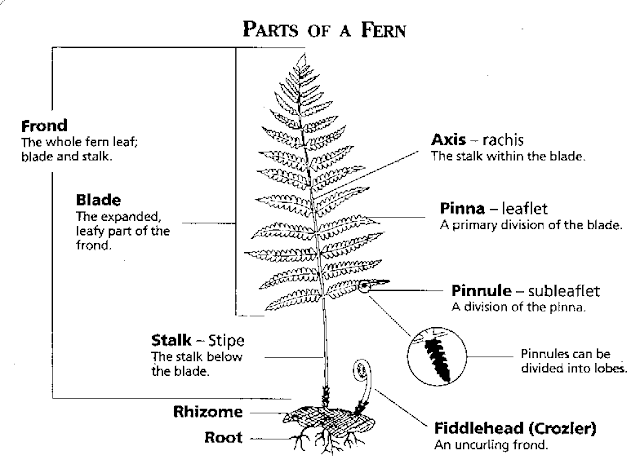Plant of the day is: Dryopteris goldiana or Goldie's wood fern
In memory of my recently passed Grandmother Fern. Here is another great fern.
Taxonomy, etc.: A member of the Dryopteridaceae family, making it the type genus for the family. There are around 250 species in the northern temperate part of the globe with the majority of diversity in eastern Asia. They have characteristically round sori and a peltate indusium (covering of the sori). The stipes have scales. Refer to my recent fern post for illustration/description of some of these ferny terms. Many of the species make great ornamental additions. Notably: Dryopteris filix-mas, Dryopteris erythrosora, Dryopteris affinis, and one of my favorites Dryopteris tokyoensis. All of these species can be found at the Missouri Botanical garden if you go a hunting! D. affinis the scaly male fern has way too fun of a name for me to not go looking for this in the Chinese Garden. D. goldiana is regarded as a parent of the rare hybrid Dryopteris x clintoniana (Clinton's wood fern)
Latin: Dryopteris = Drys (tree) and pteris (fern). The genus is commonly called the wood fern genus.
Description: A deciduous (non-wintergreen) fern with an upright vase-like habit. The tallest fern in Missouri, and I believe the largest in the genus. It can reach of heights of about 4 feet when really happy. There are reports of fronds up to 6 feet high, perhaps fish stories? I'd sure like to see one. The sori form almost right on the midrib or costa of the pinna (leaflet), which you can see in the image below. I really recommend clicking on the full res image...the closer you look at ferns the more amazing they are. So much fine detail packed in there if you stop and appreciate it. Distinguished from other Dryopteris by it's size, sori arrangement, and abruptly tapering pinna. Pinnae located near the base can be bipinnate (individual pinules) but towards the top are pinnatifid.
For a further, and excellent writeup as well as good images to accompany the description, check out:
http://www.illinoiswildflowers.info/grasses/plants/goldie_fern.html. You can clearly see the scales on the stipes on one of the photos, a common fern theme.
Full Quality Image Here
Habitat/Culture: Grouping these together because they...go together? A fairly well distributed fern along the eastern part of the country. It makes it as far west as Missouri and down into northern parts of Alabama and North Carolina. It is a fan of moist woodland areas, it needs a well drained soil rich in organic matter or humus (not hummus...you really shouldn't eat it). No google, I did NOT mean hummus. It IS a fern, so protection from strong winds will certainly help as well. Dappled shade is best, avoid full sun at all costs. North Creek Nurseries list hardiness as USDA zone 3-8 which sounds spot on. Plant these in masses...it looks fantastic and adds great texture and height in a bed. If you are looking for these in Missouri, there are scattered populations in 8 counties mostly south of the Missouri River (Steyermark).
public domain from An Illustrated Flora of the Northern United States, Canada and the British Possessions
Why is it Goldie's fern?: Glad you asked. Named after its discoverer John Goldie, a Scottish botanist (1793-1886) who collected it on a trip to North American and returned with samples in 1819. William Hooker or 'Hook' ...which you'll see all over the place for taxonomic credit...was the first to publish the species but his work was incomplete and was amended by Goldie. American botanist Asa Gray (1810-1888), who is regarded as one of the most important Botanists of the 19th century, has the most complete classification for the species. Admit it...that's WAAAAAY more than you ever cared to know and now you regret asking.












